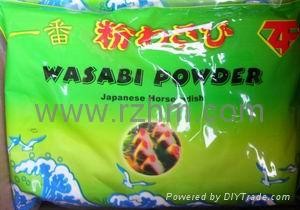Wasabi is a great compliment to almost any asian dish. wasabi is a root vegetable that is grated intou a green paste m. wasabi powder has to be mixed with water to become a paste . wasabi has astrong. hot flavor which dissipates within a few seconds and leaves no burning aftertaste in your mouth
Wasabi is a great compliment to almost any asian dish. wasabi is a root vegetable that is grated intou a green paste m. wasabi powder has to be mixed with water to become a paste . wasabi has astrong. hot flavor which dissipates within a few seconds and leaves no burning aftertaste in your mouth
Wasabi is a great compliment to almost any asian dish. wasabi is a root vegetable that is grated intou a green paste m. wasabi powder has to be mixed with water to become a paste . wasabi has astrong. hot flavor which dissipates within a few seconds and leaves no burning aftertaste in your mouth
1 Specifications 1kg/bag 10bags/CTN
2 Durability:2year
3 ingeredients: wasabi powder, mustard powder, corn starch, fd&c bule and yellow
4 Case Dimension 410mm 320mm 180mm
5 20 Feet Container 1150CTN
6 N.W. 10KG G.W 11KG
HOW TO PREPARE WASABI
1 MEASURE : WASABI POWDER 1CUP WATER 3/4 CUP ,SLOWLY ADD COLD WATER AND MIX WELL
2 KEEP THE PREPARED WASABI IN AN AIRTIGHT CONTAINER TO MAINTAIN IT
3 FOR BEST FLAVOR,SERVE WASABI 3HOURS AFTER PREPARED
4 RESEAL PACKAGE BY FIRMLY CLOSING THE ZIPPER AND STORE IN A COOL DRY PLACE
Horseradish has been cultivated since antiquity. According to , the told that the horseradish was worth its weight in gold. Horseradish was known in in 1500 BC. listed horseradish under Thlaspi or Persicon; discusses the plant in his treatises on agriculture, and a mural in showing the plant has survived until today. Horseradish is probably the plant mentioned by in his under the name of Amoracia, and recommended by him for its medicinal qualities, and possibly the Wild Radish, or raphanos agrios of the . The early Renaissance herbalists and showed it under Raphanus.
Both root and leaves were used as a during the and the root was used as a on meats in Germany, Scandinavia, and Britain. It was taken to North America during Colonial times.
mentions horseradish as Red Cole in his "Herbal" (1551-1568), but not as a condiment. In "The Herball, or Generall Historie of Plantes" (1597), describes it under the name of raphanus rusticanus, stating that it occurs wild in several parts of England. After referring to its medicinal uses, he says: "the Horse Radish stamped with a little vinegar put thereto, is commonly used among the Germans for sauce to eat fish with and such like meates as we do mustarde."
Where the English name horseradish comes from is not certain. It may derive by misinterpretation of the German Meerrettich as mare radish. Some think it is because of the coarseness of the root. In Europe the common version is that it refers to the old method of processing the root called "hoofing". Horses were used to stamp the root tender before grating it.
Wasabi is sometimes called Japanese horseradish, and its taste is very similar. However, real wasabi - wasabia japonica - is a relative of the family and an elusive little root. Like horseradish, it is a root, or , and it is grated or sliced for use in cooking. Wasabi is difficult to find because it is difficult to grow. It is expensive to buy because it is expensive to grow.
Wasabi is a fussy little plant, and has to be nurtured and brought carefully along like a delicate child. It takes about 18 months to reach its mature height of about 6 inches (36cm). Wasabi requires a constant stream of cool water, but not too cool; shade, but not too much shade; and a mild climate. Thus, the United States is not ideal wasabi-growing country, except in the Pacific-Northwest, where growers have had some success with the plant. It is also grown successfully in New Zealand, as well as in Japan.
may seize anyone who buys a genuine wasabi root. A single root may cost US$8-$10, and wasabi roots run about US$70-$100 per pound, depending on where the root was grown. Some Asian markets in larger cities may have fresh, genuine wasabi roots for sale, and a shopper will know he has the genuine article by the price .
When the wasabi is finally secured, it is prepared for eating raw by washing it, trimming any bumpy or scaly parts off with a sharp knife, and then grating it in a circular motion. A fine metal grater, such as a lemon zester, may be used, but real wasabi gourmands insist on a sharkskin grater, which they say produces a velvety grind. The grated wasabi is gathered into a ball and left to sit for a couple of minutes, to allow the heat and flavor to develop, then it is eaten. The traditional use is to eat it with sushi or sashimi, but it also may be used to flavor mustard or , as a meat sauce, or in salad dressings.





